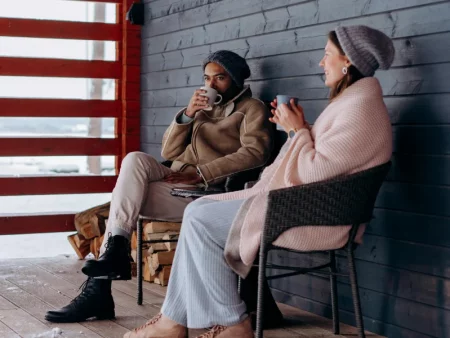Embracing vulnerability with a man can transform your relationship, forging a bond of unparalleled depth and intimacy. It’s not a weakness, but a profound strength that allows you to open your heart fully. By being vulnerable, you create a space where true connection flourishes, free from fear and self-protection.
This journey of emotional openness isn’t easy, but its rewards are immeasurable. As you share your authentic self, including hopes, dreams, and flaws, you invite your partner to do the same. This mutual unveiling builds trust, fosters understanding, and deepens your bond in ways you might never have imagined.

Embark on a transformative journey that will redefine your understanding of love, connection, and self-discovery. Let’s explore how to cultivate vulnerability and create a relationship built on authenticity and mutual growth.
Understanding Vulnerability in Relationships
Vulnerability transcends mere openness; it’s a transformative state fostering profound connection. To define vulnerability is to embrace being seen fully, flaws and all. It’s not about being weak, but having the strength to expose your true self, even when risky.
The psychology behind vulnerability reveals its power to create authentic bonds. Emotional transparency invites partners to reciprocate, creating an intimacy dance. This mutual unveiling can be challenging, requiring lowered guards and risking potential hurt. However, the benefits far outweigh the risks:
- Enhanced trust through shared experiences
- Deeper understanding and empathy
- Increased emotional connection
- Improved communication and conflict resolution
- Greater self-awareness and personal growth
To practice vulnerability, recognize its signs. It might feel like a flutter when sharing a fear or hesitation before expressing a desire. These sensations are invitations to embrace vulnerability and deepen connection.
Being honest about feelings, even when afraid, is crucial. It’s natural to want to protect ourselves, but true intimacy requires lowering walls. This doesn’t mean abandoning boundaries; instead, create a safe space for authentic self-expression.
Vulnerability extends beyond emotional disclosures; it manifests physically, from initiating affection to expressing desires. Approach these moments with openness, allowing vulnerability to work its magic in strengthening bonds.
Overcoming the Fear of Being Vulnerable
Confronting the phobia of vulnerability can feel like stepping into uncharted territory. Many grapple with the fear of rejection or judgment, creating barriers to genuine connection. However, by understanding these concerns and developing strategies to overcome them, we can unlock the transformative power of openness.
One common fear is the potential for ridicule when sharing our deepest thoughts. This security concern often stems from past experiences or societal expectations. To counter this, focus on building self-compassion and recognizing that vulnerability is a universal human experience. Gradually expose yourself to small acts of openness, celebrating each step towards authenticity.
Another hurdle is the fear of abandonment after revealing our true selves. This meaning-laden worry can be addressed by cultivating a strong sense of self-worth independent of others’ reactions. Remember, those who truly value you will appreciate your authenticity.
Vulnerability doesn’t imply losing or winning; it’s about having the courage to show up and be seen when we have no control over the outcome. This sentiment, echoed by renowned researcher Brené Brown, encapsulates the essence of true vulnerability in relationships.
To overcome these fears, consider seeking support from trusted friends or a professional. Therapy can provide a safe space to explore vulnerabilities and develop coping mechanisms. Additionally, practicing mindfulness can help manage anxiety associated with openness.
Engaging in vulnerability exercises can also build confidence. Try journaling about your feelings or sharing a personal story with someone you trust. These practices can show you the strength that lies in authenticity. Examples of such exercises include writing a letter to your younger self or expressing gratitude to someone who has impacted your life.
Remember, it’s okay to hate the discomfort that comes with vulnerability. Acknowledge these feelings without judgment, and focus on the potential for deeper connections and personal growth. By taking small, consistent steps and surrounding yourself with supportive individuals, you can gradually embrace the power of being truly seen.
Vulnerability extends beyond emotionally opening up; it also involves physical expressions of authenticity. This might include initiating affection or expressing desires, further deepening the connection with your partner.
Practical Steps to Increase Vulnerability with a Man
Cultivating vulnerability with a man requires a delicate balance of courage and sensitivity. To begin this transformative journey, start with small, manageable steps that gradually build trust and openness. One effective approach is to share a personal story from your past, revealing how it shaped your perspective or emotions. This invites your partner to see a deeper layer of your authentic self.

Communication plays a pivotal role in fostering vulnerability. Practice expressing your thoughts and feelings openly, using “I” statements to convey your experiences without placing blame or judgment. For instance, instead of saying “You never listen,” try “I feel unheard when we talk about important issues.” This approach creates a safe space for honest dialogue.
Another powerful technique is to engage in eye contact exercises. Set aside time to gaze into each other’s eyes without speaking, allowing yourselves to be fully present and connected. This wordless exchange can break down barriers and create a profound sense of intimacy.
- Share a childhood dream or aspiration you’ve never told anyone
- Admit to a mistake or regret, explaining how it affected you
- Express gratitude for specific actions or qualities in your partner
- Reveal a personal insecurity and discuss its origins
- Ask for help with a task or problem you usually handle alone
Remember, vulnerability is a two-way street. Encourage your partner to reciprocate by actively listening without judgment and expressing appreciation for their openness. As you both become more comfortable with sharing, you’ll find your connection deepening in unexpected ways.
By consistently practicing these steps and remaining patient with the process, you’ll create a foundation of trust and understanding that can withstand life’s challenges. Treat this journey as a chance for growth, both as a couple and individually. Consider keeping a journal to track your progress and reflect on the positive changes in your relationship.
Remember that vulnerability is not about oversharing or forcing intimacy. It’s a gradual process of building trust and allowing yourself to be seen authentically. As you navigate this path, be mindful of your own boundaries and respect those of your partner. With time and practice, you’ll discover the profound impact that genuine openness can have on your connection.
Creating a Safe Space for Vulnerability
Creating a safe space for vulnerability is essential in fostering deep connections. This environment allows both partners to open up without fear of judgment or rejection. To cultivate such a space, partners must consciously adopt behaviors that encourage openness while avoiding those that stifle it.
Active listening forms the cornerstone of a safe emotional environment. When your partner shares, give them your undivided attention, maintaining eye contact and offering nonverbal cues that show you’re fully present. Avoid interrupting or rushing to offer solutions; instead, validate their feelings and experiences.
Consistency in your actions builds trust over time. Follow through on commitments, respect boundaries, and maintain confidentiality. These behaviors demonstrate your reliability and trustworthiness, encouraging your partner to be more vulnerable.
| Behaviors That Encourage Vulnerability | Behaviors That Discourage Vulnerability |
|---|---|
| Practicing empathy and understanding | Dismissing or minimizing feelings |
| Expressing appreciation for openness | Reacting with criticism or judgment |
| Sharing your own vulnerabilities | Maintaining emotional distance |
| Responding with kindness and support | Using vulnerabilities against your partner |
| Offering non-judgmental acceptance | Interrupting or changing the subject |
| Providing reassurance and comfort | Comparing experiences or one-upping |
To further foster vulnerability, create rituals of connection. These could be daily check-ins or weekly deeper conversations where you both share openly. Such practices provide consistent opportunities for emotional intimacy.
Remember, crafting a safe space is a continuous process. Be patient with your partner and yourself as you go on this path together. By consistently demonstrating care and respect, you’ll build a foundation where vulnerability can thrive, leading to a more profound and authentic connection.
Vulnerability Exercises for Couples
Cultivating vulnerability in a relationship requires intentional practice and a willingness to step outside comfort zones. Here are some powerful exercises designed to deepen intimacy and foster openness between partners:
- Silent Gaze Connection: Sit face-to-face, maintaining eye contact for 5 minutes without speaking. This exercise builds trust and non-verbal communication skills.
- Appreciation Circle: Take turns expressing gratitude for specific qualities or actions of your partner. This nurtures positivity and acknowledges each other’s value.
- Fear Sharing Ritual: Set aside time weekly to share one fear or insecurity, allowing your partner to listen without judgment or trying to fix it.
- Trust Fall 2.0: Stand behind your partner and guide them, eyes closed, through a room or outdoor space. This builds trust and reliance on each other.
- Childhood Memory Exchange: Share a meaningful childhood memory, including how it shaped you. This fosters understanding of each other’s backgrounds.
- Dream Declaration: Reveal a personal dream or aspiration you’ve never shared before, explaining its significance to you.
- Vulnerability Letters: Write letters to each other expressing feelings you find difficult to verbalize, then read them aloud together.
- Mirroring Exercise: One partner expresses a thought or feeling, while the other repeats it back, ensuring clear understanding and validation.
- Touch Exploration: Take turns exploring each other’s hands or faces with eyes closed, focusing on sensations and building intimacy.
- “I Appreciate” Game: Set a timer and rapidly exchange appreciations, starting each sentence with “I appreciate…” This creates a positive feedback loop.
- Shared Goal Setting: Collaboratively create and discuss short-term and long-term goals, fostering a sense of unity and shared purpose.
- Vulnerability Scavenger Hunt: Create a list of personal questions or prompts, then take turns answering them in a relaxed, playful environment.
Remember, the key to these exercises is creating a judgment-free zone where both partners feel safe to open up. Start with what feels comfortable and gradually challenge yourselves to deeper levels of vulnerability. Regular practice can transform your relationship, fostering a profound connection based on trust and mutual understanding. Consistency and patience are crucial as you navigate this journey together, allowing each partner to progress at their own pace.
The Role of Self-Acceptance in Vulnerability
Self-acceptance forms the bedrock of genuine vulnerability in relationships. By embracing our authentic selves, flaws and all, we create a solid foundation for opening up to others. This journey begins with recognizing our inherent worth, independent of external validation or perceived shortcomings.
To cultivate self-acceptance, start by challenging negative self-talk. Replace critical inner dialogue with compassionate self-reflection. Acknowledge your strengths and achievements, no matter how small. Practice daily affirmations that reinforce your value and unique qualities.
True self-acceptance is the key that unlocks the door to authentic connections, allowing our vulnerabilities to become bridges rather than barriers. As Brené Brown, renowned researcher on vulnerability, states, “Owning our story can be hard but not nearly as difficult as spending our lives running from it.”
Mindfulness meditation can be a powerful tool for developing self-awareness and acceptance. By observing thoughts and feelings without judgment, we learn to embrace all aspects of ourselves. This practice reduces the fear of judgment from others, as we become less reliant on external approval.
Another effective technique is to keep a self-compassion journal. Write about your experiences, emotions, and challenges with kindness and understanding. This process helps reframe perceived weaknesses as opportunities for growth and connection.
As self-acceptance grows, the fear of judgment naturally diminishes. We become more comfortable sharing our true selves, knowing our worth isn’t determined by others’ opinions. This shift allows for deeper, more authentic relationships built on mutual understanding and acceptance.
Remember, self-acceptance is an ongoing journey, not a destination. Be patient with yourself as you navigate this path. Each step towards self-acceptance is a step towards more meaningful connections and a richer, more fulfilling life.
Communicating Vulnerability Effectively
Effective communication forms the cornerstone of vulnerability in relationships. To express sensitive thoughts and emotions clearly, start by creating a safe environment for open dialogue. Choose a quiet, comfortable setting where both partners feel at ease to share without distractions.
When articulating vulnerable feelings, employ “I” statements to convey your perspective without placing blame. For instance, instead of saying, “You always ignore me,” try, “I feel overlooked when my concerns aren’t addressed.” This approach fosters understanding and reduces defensiveness.
Active listening plays a crucial role in fostering vulnerability. When your partner is sharing, be as attentive as possible. Look into their eyes, nod from time to time show engagement, and avoid interrupting. Reflect back what you’ve heard to ensure understanding, saying something like, “It sounds like you’re feeling…”
Practice non-verbal cues that convey openness and receptivity. Uncross your arms, lean in slightly, and soften your facial expression. These subtle signals create an atmosphere of acceptance, encouraging deeper sharing.
Remember, vulnerability is a gradual process. Start with smaller disclosures and build up to more significant revelations as trust grows. Be patient with yourself and your partner, recognizing that everyone has different comfort levels with emotional expression.
When responding to your partner’s vulnerability, validate their feelings without trying to fix or minimize them. Phrases like, “Thank you for sharing that with me,” or “I appreciate your honesty,” can encourage continued openness.
Lastly, follow through on commitments made during vulnerable conversations. Consistency between words and actions builds trust, creating a solid foundation for future emotional exchanges. By implementing these strategies, you’ll foster a connection where vulnerability becomes a source of strength and mutual understanding.
Remember, effective communication of vulnerability requires practice and patience. It’s normal to feel uncomfortable at first, but with time, it becomes easier. As you progress, you’ll notice a deepening of your bond and a greater sense of emotional intimacy. This journey of openness can lead to a more fulfilling and authentic relationship, where both partners feel truly seen and valued.
Examples of Vulnerable Actions with a Man
Expressing vulnerability with a man can take many forms, each offering a unique opportunity to deepen your connection. Here are some powerful examples:
- Confess a long-held secret dream or aspiration you’ve never shared before
- Admit to a mistake you’ve made and sincerely apologize
- Share a childhood memory that profoundly shaped your outlook on life
- Express genuine admiration for a quality in him you’ve always appreciated but never vocalized
- Reveal an insecurity about your appearance or abilities
- Ask for help with a task you usually handle alone, acknowledging your limitations
- Share a fear about your personal growth
- Discuss a health concern you’ve been avoiding
- Open up about a past experience and how it affects you today
- Express a need for emotional support during a challenging time
- Share a personal goal and ask for his encouragement
- Admit to feeling insecure in a specific situation
- Discuss your desires and boundaries in intimate situations
- Share a moment when you felt truly seen and appreciated by him
- Express gratitude for his presence in your life, detailing specific reasons
Remember, true vulnerability involves sharing authentic feelings and experiences, even when it feels uncomfortable. Each of these actions requires courage but can significantly strengthen your bond. Start with what feels manageable and gradually push your comfort zone, always respecting your own boundaries and readiness to share.
To further enhance vulnerability, consider these additional actions:
- Share a creative work you’ve been hesitant to show others
- Discuss a family dynamic that has shaped your perspective
- Express a desire for personal growth and ask for support
- Reveal a fear about your career or financial future
- Share a moment of pride in your accomplishments
By embracing these vulnerable actions, you create opportunities for deeper understanding and connection. Remember, it’s a gradual process that requires patience and mutual respect.
Balancing Vulnerability and Boundaries
Balancing vulnerability and boundaries is essential for fostering authentic connections while safeguarding personal well-being. This delicate equilibrium allows individuals to open up emotionally without compromising their core values or safety. By establishing clear limits, one creates a secure foundation from which to explore deeper levels of intimacy.
Healthy boundaries act as guideposts, defining acceptable behaviors and interactions within relationships. They provide a framework for respectful communication and mutual understanding. When coupled with vulnerability, these boundaries enable individuals to share openly while maintaining a sense of self and autonomy.
| Aspect | Vulnerability | Boundaries |
|---|---|---|
| Purpose | Fosters connection | Ensures self-respect |
| Expression | Sharing emotions | Setting limits |
| Outcome | Deepens intimacy | Maintains individuality |
| Risk | Potential hurt | Possible distance |
| Growth Area | Emotional openness | Self-awareness |
| Communication | Expressing needs | Asserting preferences |
| Trust Impact | Builds trust | Reinforces respect |
To maintain this balance, it’s crucial to communicate personal limits clearly and consistently. This involves expressing needs, desires, and concerns openly while respecting others’ boundaries. By doing so, individuals create a safe space for vulnerability to flourish without sacrificing personal integrity.
Regularly reassessing and adjusting boundaries ensures they remain aligned with evolving personal values and relationship dynamics. This ongoing process allows for flexibility while maintaining a strong sense of self. Ultimately, the interplay between vulnerability and boundaries cultivates relationships built on trust, respect, and genuine connection.
Consider implementing a “check-in” system with your partner to discuss boundaries and comfort levels regularly. This proactive approach fosters open communication and mutual understanding, creating a solid foundation for healthy vulnerability.
Frequently Asked Questions About Being Vulnerable with a Man
How can I tell if it's safe to be vulnerable with someone?
Assessing safety for vulnerability involves observing consistent patterns of respect, empathy, and trustworthiness. Look for active listening, non-judgmental responses, and reciprocal sharing. Notice how they handle sensitive information and react to others' vulnerabilities. Trust your intuition and pace yourself, gradually increasing openness as mutual trust builds. Consider their past actions and reliability in maintaining confidentiality.
Can being too vulnerable be harmful in a relationship?
Excessive vulnerability can indeed be detrimental. Oversharing personal information too quickly may overwhelm your partner or create an imbalance in emotional intimacy. It's crucial to pace self-disclosure, respecting both your own and your partner's boundaries. Healthy relationships thrive on gradual, mutual openness that allows trust and understanding to develop organically over time. Striking this balance fosters deeper connections.
How long does it take to build trust for vulnerability?
Building trust for vulnerability varies for each individual and relationship, typically unfolding over weeks or months of consistent, positive interactions. Past experiences, communication styles, and emotional readiness influence the timeline. Patience, empathy, and small acts of openness accelerate trust-building, creating a foundation for deeper connections. Regular check-ins foster mutual understanding and growth.
What's the difference between being vulnerable and oversharing?
Being vulnerable involves sharing genuine emotions and experiences to foster connection, while oversharing discloses excessive personal details without context consideration. Vulnerability builds trust gradually, whereas oversharing can overwhelm listeners. The key difference lies in intention, timing, and respect for mutual comfort levels. Purposeful openness strengthens relationships, while indiscriminate sharing may create discomfort.

Gay Hendricks, born on January 20, 1945, is a renowned American psychologist and author specializing in personal growth, relationships, and body intelligence. He earned his Ph.D. in psychology from Stanford University in 1974 and later taught at the University of Colorado, where he became a full professor in the Counseling Psychology Department. During his 21-year tenure there, he founded The Hendricks Institute.













